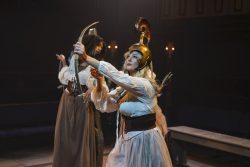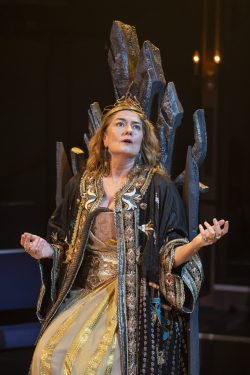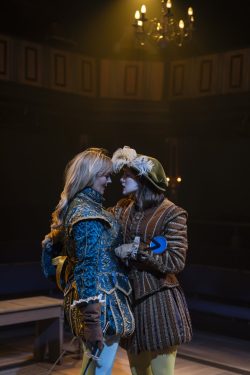 APRIL de Angelis’s play Playhouse Creatures, commissioned by Sphinx Theatre in Leicester in 1993, might have been a historical drama about the life of the famous Mary Betterton, known as the first actress of the English stage – or about Nell Gwynn, the orange seller who enraptured King Charles II.
APRIL de Angelis’s play Playhouse Creatures, commissioned by Sphinx Theatre in Leicester in 1993, might have been a historical drama about the life of the famous Mary Betterton, known as the first actress of the English stage – or about Nell Gwynn, the orange seller who enraptured King Charles II.
But it is much more than that, timelessly bringing the plight of women in a man’s world into the spotlight. It all begins in a darkened theatre, once a bear pit, where Doll Common and Nell Gwynn meet. They are dead … ghosts of a theatre company that had marked the high point of the Restoration. Doll remembers her cruel father beating a bear who refused to dance, and she hears the bears roaring in the shadows of the stage, where clumps of their fur are still tucked into the brickwork.
 By 1666 Mrs Betterton, wife of the manager of the Duke’s Company, Thomas, has played almost every leading character available, acting, singing and teaching younger actresses. Orange Nell, aged 16, wants to become an actress.
By 1666 Mrs Betterton, wife of the manager of the Duke’s Company, Thomas, has played almost every leading character available, acting, singing and teaching younger actresses. Orange Nell, aged 16, wants to become an actress.
But what ARE the women on stage to the men who form the audience? At best, they are the playhouse creatures of the title – there to titillate (literally) by bodily exposure and ribald remarks … and to leave the theatre for assignations with various noblemen and royalty. The high-principled Mrs Betterton is their conduit, pleading their case for co-operative shareholding to the remote and famous Mr B. It all happened
This new production, which opened at The Orange Tree in Richmond, is directed by Michael Oakley, who also directed the play at Theatre on the Fly in Chichester in 2012. Anna Chancellor plays Mrs Betterton, whose guidance as to the set of the head is still followed by some leading actresses today. Here is a woman who has set the pace for her female stage successors, not only taking all the major roles, but standing in for male actors unable (mostly through drink or debauchery) to get to the theatre in time for the curtain. This was a time before women were permitted on stage, and so her contributions were hidden by make-up and acting talent.
 Now Mrs B is being written out of the plot, as she watches the younger actresses take over, and is aided by Dona Croll’s wonderful Doll Common, the faithful dresser, cleaner, stage extra and confidante.
Now Mrs B is being written out of the plot, as she watches the younger actresses take over, and is aided by Dona Croll’s wonderful Doll Common, the faithful dresser, cleaner, stage extra and confidante.
The actresses faced not only exploitation by actors, but the derision that inevitably followed their liaisons with members of the audience – and pregnancies which ended any chance of a lasting career. Nicole Sawyerr’s Mrs Farley was not lucky. Nell Gwynn, as we know, not only caught but kept the eye of the king. Zoe Brough’s pertly determined Nell kept her focus, while her colleague Mrs Marshall (Katherine Kingsley) recklessly pursues a hopeless quest to shame the earl who tricked her into a false marriage.
The play captures the excitement and romance of the theatre, and the enduring promise of fame, glamour, artistry and beauty – with their flipsides of squalor and abject rejection, public vilification and dashed hopes. And that was in a time before social media.
Remember the recent case about the female BBC presenters being paid significantly less for doing the same job as their male counterparts? … hear the bears roar?
GP-W
Photographs by Ellie Kurttz